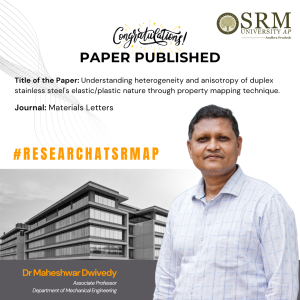 In a remarkable achievement, Dr Maheshwar Dwivedy, Associate Professor in the Department of Mechanical Engineering, has made a significant contribution to the field of materials science with his latest publication. The paper, entitled “Understanding heterogeneity and anisotropy of duplex stainless steel elastic/plastic nature through property mapping technique,” has been published in the esteemed journal Materials Letters, which boasts an impact factor of 3.0.
In a remarkable achievement, Dr Maheshwar Dwivedy, Associate Professor in the Department of Mechanical Engineering, has made a significant contribution to the field of materials science with his latest publication. The paper, entitled “Understanding heterogeneity and anisotropy of duplex stainless steel elastic/plastic nature through property mapping technique,” has been published in the esteemed journal Materials Letters, which boasts an impact factor of 3.0.
Dr Dwivedy’s research provides insightful analysis of the complex behaviours of duplex stainless steel, a material known for its high strength and corrosion resistance. By employing a property mapping technique, the study reveals the intrinsic heterogeneity and anisotropy of the material’s elastic and plastic properties. This groundbreaking work not only advances the understanding of duplex stainless steels but also opens up new possibilities for their application in various industries.
The publication of this paper in a journal with a significant impact factor is a testament to the quality and importance of the research conducted by Dr Dwivedy and his team. It underscores SRM University – AP’s commitment to fostering cutting-edge research and innovation.
Abstract
Accelerated property mapping, an advanced indentation technique, was used to describe the nanomechanical behaviour of duplex stainless steel (DSS) surfaces prior to and post-heat treatments. Heterogeneity in deformation responses and relative elastic and/or plastic nature of DSS was assessed on longitudinal and transverse directions through load-displacement curves, property maps, histograms of hardness (H), modulus (E) and indentation works. Empirical ratios such as H/E, (H/E)1/2, H3/E2 and plasticity index were employed to understand the anisotropy across the directions. It is crucial that for structural designing, heterogeneity and anisotropy of mechanical behaviour need to be accounted for improved property–optimisation.
Explanation of the Research in Layperson’s Terms
Duplex stainless steel (DSS), a unique category of steel, contains almost equal amounts of ferrite and austenite phases within its microstructure. These are employed in applications like boilers, pressure vessels, heat exchangers, etc., as they offer superior strength, ductility, toughness, and corrosion resistance properties compared to other steels. Mechanical characteristics of DSS are significantly influenced by manufacturing protocols including heat treatments. It is believed that anisotropy and heterogeneity in mechanical behaviour can be driven by microstructures post-material processing.
A comprehensive understanding of DSS material behaviour at the macroscopic scale is not feasible without knowledge of its features and their properties locally. Although the mechanical properties of DSS have been widely explored from a macroscopic perspective as well as innovative nano-scale property mapping techniques, the number of studies addressing anisotropy seen through small-scale characterization is rather restricted. In general, the preliminary assessment of the mechanical behaviour commonly done through hardness (H) and modulus (E) properties. For estimating the elasticity and/or plasticity of material or any surface, different empirical ratios were adopted namely H/E, H3/E2 and (H/E)1/2.
Practical Implementation or the Social Implications Associated
• This study demonstrates the notable differences in mechanical properties in longitudinal and transverse directions along with heterogeneity before and after heat treatments.
• It is felt crucial that for structural designing, heterogeneity and anisotropy of mechanical behaviour need to be accounted for improved property-optimisation.

